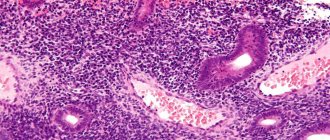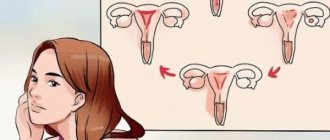The endocervix is an epithelium that connects the uterus to the vagina, secreting mucus. The latter performs important functions: it prevents infections from entering the vagina and creates microflora useful for this organ. Endocervical cysts are benign neoplasms. They are capsules filled with thick mucus located on the cervix. Typically, the pathology occurs in women aged 25-45 who have given birth.
Most nabothian cysts have no symptoms and are only detected on ultrasound. An important feature is that as a result of suppuration and/or inflammation, the ovarian cyst becomes malignant. They have ICD-10 code N83 - non-inflammatory diseases of the genital organs.
Description of the disease
In general, the endocervix is the mucous membrane of the cervical uterine canal connecting the uterus to the vagina. The mucous membrane contains special nabothian glands that secrete cervical mucus. It, in turn, performs the functions of protecting against infections and other harmful microorganisms in the uterus and creating a favorable environment in the vagina. In the area of gland secretion, cysts arise when the excretory ducts are blocked. They are also called nabothian cysts. The inside of such a tumor is filled with fluid, the outside is covered with a capsule of epithelial tissue cells.
Classification
This disease is classified according to quantitative characteristics and size. During diagnostic procedures, it is possible to detect the following types of neoplasms:
- single. That is, only one neoplasm was detected. There is a risk that it may become large. This, in turn, can lead to serious complications, such as disruption of the transport function of the cervical canal, etc.
- multiple. In this case, several formations are diagnosed. With this option, the cysts usually do not increase in size and do not lead to disruption of the functioning of the pelvic organs.
Small tumors are worth highlighting separately. Such tumors often occur after childbirth or treatment of erosion.
It is important to determine the type of disease in order to prescribe the correct courses of treatment.
Symptoms
At the initial stages, it is extremely difficult to determine the presence of this disease in a woman’s body. The neoplasms do not manifest themselves in any way. Diagnosis sometimes occurs by chance during periodic gynecological examinations. If the formations are large, the following symptoms may occur:
- bleeding;
- pain in the lower abdomen;
- disturbances in the monthly cycles (when the cervical canal is narrowed, the free outflow of menstrual blood is difficult, which can lead to abdominal pain, the development of endometritis, cycle disruption, etc.);
- impossibility of conception (infertility can occur if the canal is completely blocked by tumors);
sensation of the presence of a foreign body inside (may occur during douching and sexual intercourse).
During the inflammatory process, breakthrough bleeding with the release of an unpleasant odor may be added to the symptoms.
Prevention
As noted above, endocervical cysts on the cervix are a fairly common pathology. To prevent its development, it is first of all recommended to follow the rules of personal hygiene and choose the right products to care for this area. In addition, it is necessary to promptly treat all existing ailments and complications. It is also important to undergo a preventive examination with a gynecologist twice a year. The thing is that in the early stages of the formation of tumors it is much easier to eliminate them.
Reasons for appearance
For further research, the cause of the disease is determined using high-precision methods. Let's consider the main ones:
- During natural childbirth, there is a risk of damaging the internal tissue of the uterus, which will contribute to the occurrence of the disease. During childbirth, the baby can damage the walls of the uterus.
- Instrumental interventions can detect endometrial polyps. In addition, tumors may occur after childbirth or other surgical interventions.
- Infections. The main representative is the human papillomavirus.
- Often, when using intrauterine contraceptives, tumors may occur in the cervix.
Diagnostic measures
Various studies can serve as methods for detecting and diagnosing the disease. These include:
- gynecological examination, examination of the cervix in the speculum, palpation (possible detection of formations in the outer part of the cervix);
- Ultrasound of the uterine cervix;
- colposcopy;
- taking a smear for oncocytology, biopsy and histological examination;
- bacterial culture of secretions;
- PCR analysis.
Depending on the complexity of the disease, various additional studies may be prescribed. Tests may include a general blood and urine test, tests for the presence of hormones, and tumor markers.
After carrying out all the activities related to diagnosis, the doctor will determine the cause of the appearance of cystic nodes and prescribe treatment for the activating disease, surgical removal or observational procedures in mild cases. Along the way, they may prescribe hormonal, anti-inflammatory drugs and vitamins.
Diagnostics
If primary symptoms of this pathology appear, it is recommended to consult a doctor. In some cases, endocervical cysts of the cervix are discovered during the next gynecological examination. However, in order to finally confirm this diagnosis, the doctor must prescribe the following procedures:
- Ultrasound of the cervix. This study allows you to detect even minor changes in tissue structure.
- A smear to determine the presence of various types of infections of the genitourinary system. This study is carried out to exclude other diseases with similar symptoms. The thing is that removing the tumor is impossible until other ailments are cured.
- Extended colposcopy. The tissues of the cervix are examined under a microscope, which allows us to obtain the most accurate information about their structure and possible changes.
- Oncocytology. A smear is taken from the patient to rule out the presence of malignant changes.
- PAP smear. This test allows early detection of primary signs of cell degeneration (precancerous condition). It is carried out using coloring indicator compounds.
Treatment
The treatment method is selected after diagnosis and conversation with a gynecologist. If the disease does not pose a great threat, the size of the neoplasms is small, there is no inflammation or infection, then surgical intervention is not required. If there are good indications in the studies, periodic visits to the gynecologist every three months are necessary. This approach can be called a wait-and-see approach. If complications or changes for the worse are noticed, the gynecologist may recommend treatment or removal.
Drug therapy is not able to completely rid the body of a cyst. But, if there is a known disease that contributes to the appearance of nodes, drugs will help stop the disease and recurrence of formations in the cervix. Also, medications can get rid of favorable conditions under which the formation of cervical nodes is possible. For this purpose, hormonal, antibacterial agents, and contraceptives are used. Immunostimulating and vitamin complexes are used as auxiliary medications.
Surgical intervention can be prescribed for suppuration and inflammation, for large cavity sizes (from 10 mm), for problems with conception and severe pain. The operation will not only get rid of suppuration, but also avoid subsequent relapses.
Surgical removal techniques:
- Diathermocoagulation (removal using electric current);
- Cauterization with chemicals;
- Vaporization (exposure to nodes with a laser beam);
- Radio wave therapy (puncture of the walls of the formation with a radio wave);
- Cryotherapy or cryodestruction (exposure to liquid nitrogen).
The last three methods are considered the safest. The impact with their help occurs exclusively on atypical cells, as a result, neighboring tissues are not damaged, deformations and rough scars do not occur. The procedure lasts from 3 to 7 minutes, together with preparatory measures - no more than half an hour.
Contraindications for surgical removal:
- cancerous changes in cells;
- cyclic bleeding;
- pregnancy and breastfeeding;
- acute infectious diseases;
- venereal diseases;
- endometriosis, fibroids, polyp of the uterine canal mucosa.
How to treat the disease
Women with this diagnosis are wondering how to treat capsules in the uterus with the possibility of becoming pregnant in the future. The answer is simple: you need to undergo examinations. If the capsule is small, the doctor will prescribe medications, but to get rid of a large tumor, surgery will be required.
List of medications
The main list of medications recommended by doctors:
- Antibacterial agents. The best choice would be Tetracycline or Ampicillin, but talk to your doctor about the dosage. If you exceed the dosage, complications will appear: skin itching, vomiting, nausea, swelling, fever.
- Antiseptics. The drug "Cimesol" is an excellent tool for accelerating the growth of connective tissues and disinfection.
- Vitamins. The Nutrimax vitamin complex will strengthen the immune system and direct the body’s strength to the problem that worries the patient.
During the course of treatment, it is not recommended to drink alcohol for the greatest effectiveness of the drug.
You should not self-medicate; it is better if the patient seeks advice from a specialist.
Folk remedies
Prevention of cyst treatment are folk “helpers”. The growth of the capsule is stopped with the help of a tincture of medicinal herbs. The recipe is simple: mix rose hips with sea buckthorn, add plantain, chamomile, then grind everything and pour a liter of boiling water. Let it sit for 7-8 hours. We take 2-3 teaspoons per day.
- The egg drink will help restore the mucous membrane in the cervix. Grind 8 pre-cooked yolks until crumbly, add 4 teaspoons of crushed pumpkin seeds. Pour 500 ml of sunflower oil and leave the drink for 15-20 minutes. to a water bath. We drink two teaspoons in the morning for a week.
- Treatment with garlic. Take a clove and wrap the garlic in a bandage or gauze to form a “tampon” of garlic. Before going to bed, administer orally for 30 days.
- Grind 100 g of burdock leaves to obtain juice. Drink it one teaspoon in the morning and evening for a month.
- Take a teaspoon of chamomile flowers, nettles, celandine leaves, sea buckthorn, plantain and pour a liter of boiling water. We insist for 9 hours, for two weeks we drink a teaspoon in the morning and evening.
- Pour 2 tablespoons of acacia flowers with vodka or medical alcohol (180-200 ml). Leave the mixture to steep for 5 days, filter on the 6th day, consume 10 ml, diluting 35 ml with boiled warm water.
- Grind the fruits of joster, nettle, string, violet, valerian rhizomes, wormwood, walnut (green) leaves, St. John's wort, oregano, knotweed, immortelle, horse sorrel rhizomes, centaury. Mix erasthenia, pour two tablespoons with 200 ml of boiling water. Leave for 4-5 hours, strain, drink 70-80 ml of tincture per day for 30 days.
- Place a small onion in the oven without peeling the vegetable. Every morning for a week, eat one baked onion without adding oil or salt.
- Grind corn silk, calendula flowers, chamomile, then mix the raw materials. Pour 500 ml of boiling water, leave for 5 hours and let cool. Filter and rinse your vagina with this solution.
Within a week, using candles made from natural products will help. Keeping a 3 to 1 ratio, mix butter and honey. Next, we “fashion” a candle from the substance and put it in the refrigerator. Insert the suppository into the vagina in the evening for one week.
Complications
If the disease is diagnosed late or for other reasons, a number of complications may arise. These include:
- cervical rupture during childbirth;
- infertility;
- problems during childbirth, in the worst case including miscarriage;
- suppuration and abscess;
- constant inflammatory processes;
- development of cervical cancer (not transformation from a benign tumor to a malignant one, but the independent appearance of cancerous tumors against the background of a favorable inflammatory environment in the uterus).
On their own, cysts of the vaginal part of the cervical canal do not pose a threat to the patient’s health. Small tumors are not characterized by growth. Tumors do not degenerate into cancer unless there are special prerequisites for this. The asymptomatic course becomes difficult for diagnosis. The absence of signs leads to the fact that tumors are detected against the background of complications - inflammation, ectopia.
Pregnancy against the background of endocervical formations
Exocervical and endocervical cysts do not change hormonal levels and do not interfere with ovulation. They do not interfere with the maturation of the egg, its release from the ovary and its movement through the fallopian tubes. They do not affect implantation - the introduction of the fertilized egg into the wall of the uterus. Against the background of pathology, successful conception, pregnancy and birth of a child are possible.
Problems arise when complications develop:
- Chronic cervicitis. A retention cyst is a potential source of infection. It is a reservoir for pathogenic microorganisms and supports the inflammatory process. Chronic cervicitis changes the flora of the genital tract. The environment becomes alkaline and the progress of sperm slows down. Problems arise when conceiving a child,
- Inflammation of the pelvic organs. Chronic cervicitis without treatment leads to the spread of the process into the uterine cavity and its appendages. Endometritis and salpingoophoritis develop. When the ovaries are damaged, the ovulation process is inhibited and the egg does not mature. Inflammation of the fallopian tubes leads to blockage of their lumen and ectopic pregnancy. Endometritis prevents complete implantation of the chorion and causes spontaneous miscarriage, intrauterine infection of the fetus and premature birth,
- Deformation of the cervix and narrowing of its lumen. Large single cysts or multiple small ones change the structure of the organ. The lumen is blocked by the formation, and the outflow of blood from the uterine cavity is disrupted. This leads to the development of an inflammatory process and prevents the conception of a child. The movement of sperm through the genital tract is also difficult,
If the cervix is deformed, the ability to conceive a child is significantly reduced.
- Isthmic-cervical insufficiency. Cystic formations prevent the cervix from performing its main task - blocking the exit from the uterine cavity. It opens prematurely and a miscarriage occurs. Pregnancy is terminated at 16-26 weeks. To correct ICI, suturing of the cervix is performed. An obstetric pessary can be used.
Serious complications from endocervical cysts are rare, and they can usually lead to pregnancy. If pathology is detected during gestation, it is not treated. Examination and observation are indicated. The cyst is removed after childbirth. Therapy is prescribed only for concomitant cervicitis.
On a note
Cervical endometriosis may regress during pregnancy. After childbirth, a relapse of the disease is possible.
With a cervical cyst, vaginal delivery is possible if there are no obstacles to the passage of the fetus. Planned caesarean section is indicated for multiple and large formations.
Is it necessary to treat an endocervical cyst before pregnancy? It is advisable to get rid of retention formations before conceiving a child. You should not leave a potential source of inflammation in the body. Small endometrioid lesions do not interfere with the onset and course of pregnancy, so they do not require special treatment.
Small endometrioid lesions on the cervix, as a rule, do not prevent a woman from becoming pregnant and bearing a child.
You can plan a pregnancy after the cervix has healed. The duration of the rehabilitation period depends on the type of therapy. After radio wave and laser cauterization, recovery takes 4-5 weeks, and you can conceive a child in the next cycle (after the first normal menstruation). If cryodestruction or electrocoagulation was performed, you should wait 8-12 weeks. The doctor will tell you the exact timing after the follow-up examination.
Preventive measures
The basis of preventive measures will be maintaining immunity and a rational approach to the health of the body. A healthy lifestyle, hygiene measures, protection during sexual intercourse - all this will reduce the risk of benign tumors. To ensure that cervical nodes do not form as a result of pregnancy, it is necessary to take all measures necessary to reduce the risks of complications during pregnancy.
Related posts:
- All about female insomnia and the fight against it, or how to fall asleep without counting sheep Female insomnia, or insomnia, is a problem for every third modern…
- Hypertension is a problem of high blood pressure. Hypertension is a cardiovascular disease characterized by chronically high blood pressure...
- Osteoarthritis of the knee joints - personal treatment experience I want to share my real story of recovery without medications. It happened,…
- Causes and terrible consequences of heartburn A burning sensation in the chest area is called heartburn. However, she...











